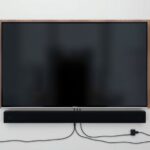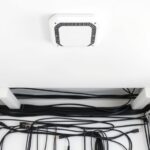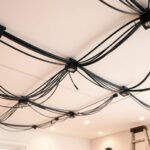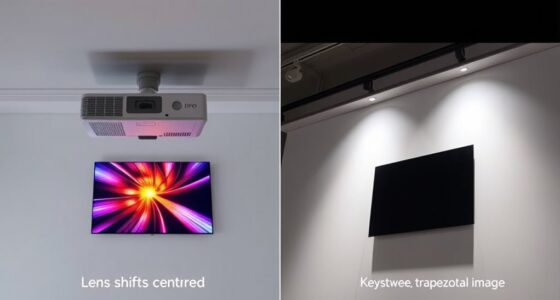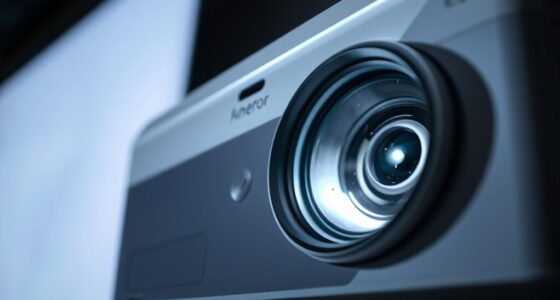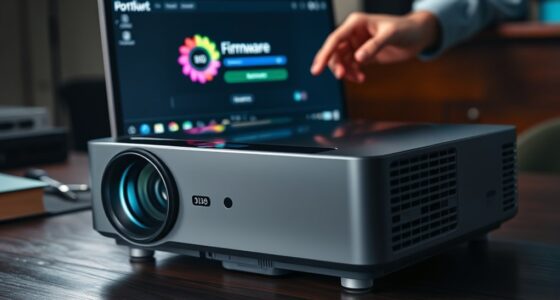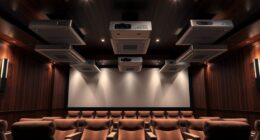To keep your setup neat and safe, start by grouping similar cables and using cable ties or Velcro straps to organize them. Use cable sleeves, clips, or conduits to route cords along surfaces and avoid clutter. Label your cables for easy identification, and plan your routing to minimize hazards. Regularly check your cables and ties to guarantee everything stays secure. Keep these tips in mind, and you’ll discover more ways to optimize your cable management.
Key Takeaways
- Group similar cables and use ties or Velcro straps to keep them organized without causing damage.
- Use cable sleeves, conduits, or organizers to protect and conceal cables, maintaining a clean setup.
- Label cables with tags or color codes for quick identification during troubleshooting or upgrades.
- Route cables along walls or under desks to minimize hazards and avoid high-traffic areas.
- Regularly inspect and replace damaged cables and ensure all ties and mounts remain secure.
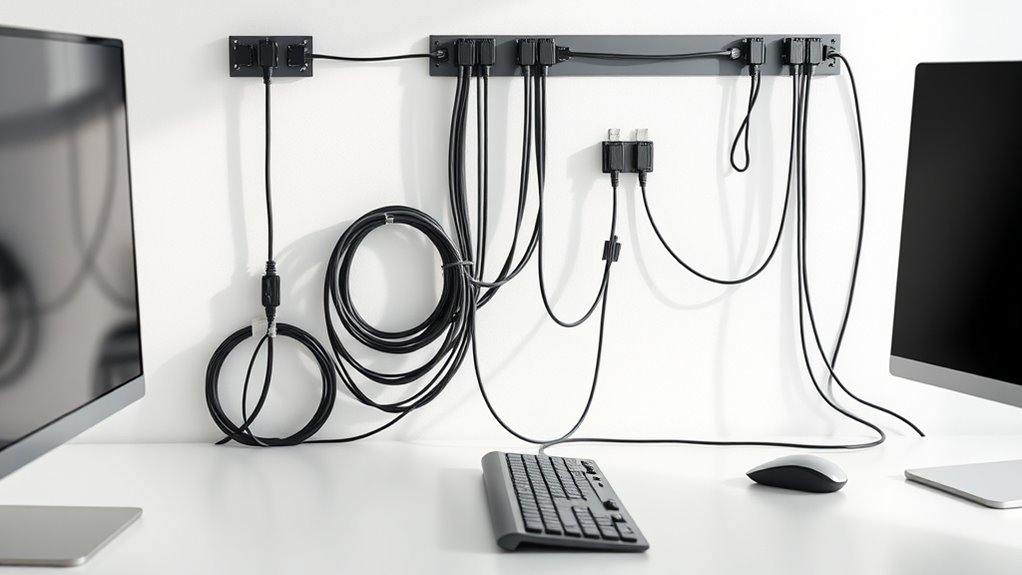
Managing cables effectively can prevent clutter and improve safety in any space. Whether you’re setting up a home office, a media center, or a workshop, good wire management makes a significant difference. When you focus on cable organization, you not only create a cleaner environment but also reduce the risk of tripping hazards and equipment damage. The key lies in implementing simple yet effective strategies that keep your cables tidy and accessible.
Start by evaluating your setup and identifying all the cables that need managing. Group similar cables together—such as power cords, HDMI cables, or USB connections—so you can handle them as a unit. Using cable ties or Velcro straps helps keep these groups neat and prevents tangling. Avoid over-tightening, as this can damage the cables or make adjustments difficult later. When you bundle cables, make sure there’s enough slack to prevent strain on connectors, which can lead to wear or failure over time.
Another essential aspect of wire management is choosing the right tools and accessories. Cable sleeves or conduit protect cables from wear and tear while keeping them concealed. Cable clips or adhesive mounts can route cords along walls or desks, preventing them from sprawling across floors or work surfaces. Consider using cable organizers, such as cable trays or sleeves, to keep everything in place. These solutions not only improve aesthetics but also streamline access when you need to disconnect or move devices.
Labeling plays an important role in cable organization, especially in setups with multiple devices. Use labels or color-coded tags to identify each cable’s purpose and connection point. This simple step saves you time when troubleshooting or upgrading your system. Additionally, investing in cable management boxes or enclosures helps hide excess lengths and power strips, making your space look tidy and professional.
Planning your cable routing carefully is crucial to maintaining a safe setup. Keep cables away from high-traffic areas to avoid accidental pulls or tripping. Run cables along walls or under desks whenever possible, rather than across open spaces. Regularly check your cable organization to verify ties remain secure and cables are not frayed or damaged. Proper wire management isn’t a one-and-done task; it requires ongoing maintenance to sustain a safe and neat environment. Incorporating quality cable accessories can further enhance durability and ease of use over time.
Frequently Asked Questions
How Often Should I Replace Cable Management Accessories?
You should replace cable management accessories when they become damaged, worn, or no longer serve their purpose effectively. Regularly check your cable labeling and wire color coding for signs of wear or fading, which can cause confusion or safety issues. Typically, inspecting every 6 to 12 months helps ensure your setup remains safe and organized. Upgrading accessories periodically can also improve cable management and make troubleshooting easier.
Can Cable Management Improve Device Longevity?
Yes, cable management can improve device longevity by reducing wear and tear on your cables. Properly organized cables experience less stress, bending, or accidental pulls, which enhances their durability. When you keep cables neat and secure, you prevent unnecessary strain that can cause damage or degrade cable performance over time. By maintaining good cable habits, you extend the life of your devices and avoid costly replacements.
Are There Eco-Friendly Cable Organization Options?
Did you know that over 300 million tons of plastic waste are produced globally each year? You can choose eco-friendly cable organization options like recyclable organizers made from sustainable materials. These options help reduce plastic waste and are better for the environment. By switching to eco-friendly materials, you not only keep your cables tidy but also contribute to a greener planet. Making small changes can have a big impact!
How Do I Handle Cables in Shared Workspaces?
In shared workspaces, you should label cables to avoid confusion and guarantee easy identification. Keep power strips accessible but organized, ideally mounted or placed on desk edges to prevent clutter. Use cable clips or sleeves to group cords together, reducing tangles. Clear labeling and strategic power strip placement help maintain a tidy environment, improve safety, and make it easier for everyone to disconnect or troubleshoot cables quickly.
What Are the Best Practices for Cable Management During Travel?
When traveling, you should label your cables, use portable cable organizers, and pack accessories in designated compartments. Labeling helps you quickly identify each cable, avoiding confusion. Portable cable organizers keep everything tidy, preventing tangles and damage. Packing accessories systematically ensures easy access and saves space. By combining cable labeling, portable cable organizers, and organized packing, you create a seamless, efficient travel setup that keeps your cables safe and accessible wherever you go.
Conclusion
By keeping your cables organized, you’re turning a tangled jungle into a smooth highway. With a few simple tips, you can prevent accidents, improve safety, and make your setup look sleek and professional. Remember, a tidy cable setup isn’t just about looks—it’s about creating a safe and efficient environment. Think of your cables as the veins of your tech world; when they’re well-managed, everything flows seamlessly, keeping your space healthy and clutter-free.
Carl is the author of 1home Theatre Projector. When he’s not busy writing about all things projector-related, you can find him playing basketball or watching a good movie. He knows that jumping to a projector-based home cinema can be daunting, but he’s here to help make it as easy as possible. With his comprehensive guides and product reviews, you’ll be able to find the right projector for your needs and set it up in no time. Plus, he’s always on top of the latest news and information on upcoming releases, so you’ll always be ahead of the curve.


